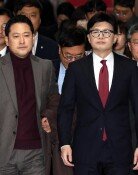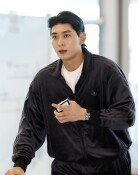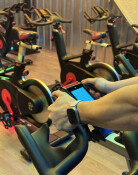Reporter`s look at P`yang
At 6 a.m. Sunday, a group of Korean, U.S. and Japanese reporters finished entry procedures in the Sunhan Airport of Pyongyang and headed for the hotel, and it was already dark.
When we drove for about 10 minutes along the scantly lighted streets, dazzling light suddenly came in our sight. There was the Kumsusan Memorial Palace, where the body of the late Kim Il-Sung is interred. With the gaze upon the large portrait of the late North Korean leader, we were awakened to be in North Korea.
At dawn Monday, the light in the airport was put out all of a sudden, as we were waiting for the arrival of U.S. Secretary of State Madeleine Albright. The airport was lighted several minutes later. Seeing that the light was cut amidst an event for greeting the visiting secretary, we were reminded of the difficulty in the electric supply in the North.
When we were returning from news coverage, it was the rush hours for business office attendance. On streets with scarce pedestrians, we saw a procession of military trucks with soldiers on board. The soldiers looked upon us aboard news media cars with the curious eyes, and some of them waved their hands. From their candid and smiling faces, there were no traces of the "arch-enemies of the American imperialists."
At the moment, this reporter recalled the cold eyes of the North Korean soldiers upon us, as the South Korean tourists were sightseeing at Mount Kumgang shortly after the tourism program began in November 1998. Are even the soldiers changing now?
The collective gymnastic performance held at the May 1 Stadium to mark the 55th anniversary of the ruling Worker¡¯s Party, in the evening, with the attendance of North Korean Defense Commission Chairman Kim Jong-Il and Albright gave us a poignant impression.
The reporters were seated in the VIP lobby, where the North Korean leader was to take a seat. The stadium permeated with silence, and tension turned into the area if wild cheers, as soon as a music band played a welcoming march to herald Kim's entry into the stadium. The performers as well as the audience chanted ¡®manse¡¯ (cheers) with emotional expressions and jumping. The guides for the reporters did the same thing.
The mass game that lasted one hour and 10 minutes was indescribably grandiose and precise to give us shudders. Hundreds of thousands of students and soldiers moved in unison as a machine.
Nonetheless, we felt that even there were humans breathing. The window sills were adorned with flower pots, and on the streets were seen some draft beer and liquor shops. The people this reporter came across looked candid and friendly.
A 25-year-old woman guide for foreigners quipped with a smile that in the North too there is a saying that handsome men are in the South and beautiful women in the North. I wish I could marry a South Korean man, when unification is realized, she said shyly.
Due to the influence of the inter-Korean exchanges, citizens in the capital of Pyongyang got used to seeing products from the South. In the cafe on the second floor of the Koryo Hotel was a South Korean-made television set, and our guide was bringing with him a South-made camcorder.
A guide told the reporters that he knew that South Korean President Kim Dae-Jung had received the Nobel Peace Prize, although he is not aware well of the prize exactly. He added that the award was highly welcomed, as it was awarded for his endeavors for the inter-Korean reconciliation and cooperation.
Before leaving Pyongyang after finishing the news coverage, an American reporter insisted on Washington's prudent approach to the North, cautioning that the summer does not come merely because of a swallow coming. But this reporter responded with the Korean saying that the beginning is half done.







